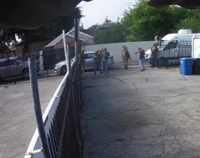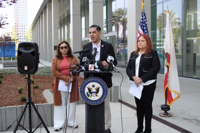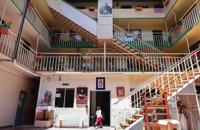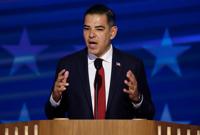
Every year, activists, human rights organizations and legal groups meet on January 11, which marks the anniversary of the first detainee sent to Guantánamo Bay. They gather to protest the ongoing operation of the Guantánamo Bay detention center. This year, it was held on Tuesday, February 11, due to the air quality issues in early January caused by the Pacific Palisades and Eaton Canyon fires.
Organizers from various struggles, including the American Civil Liberties Union (ACLU) Los Angeles, CAIR Los Angeles, Amnesty International, Jewish Voice for Peace, U.S. Hands Off Cuba Committee Los Angeles and National Lawyers Guild, gathered in front of the U.S. Federal Building in Westwood.
The Guantánamo Bay detention facility, situated on Cuban land occupied and controlled by the United States, has a long history of denying due process, visitors and religious practices and extracting forced confessions.
This year’s protest weighed heavier because, on January 29, President Trump signed an executive order entitled “Expanding Migrant Operations Center at Naval Station Guantánamo Bay to Full Capacity.” The directive was something he promised to enact in his first term.
On Wednesday, February 5, the Department of Defense released a memo titled “First Flight of Illegal Aliens Arrives at Guantánamo.” People arrived with many questions unanswered regarding the decision's legality and the detention center's conditions, considering that in 2015, the National Defense Authorization Act (NDAA) stated there was a “prohibition on use of funds to construct or modify facilities.”
Now that President Trump is sending migrants to Guantánamo Bay, it has sparked outrage within the immigrant community regarding whether those sent there will receive proper care and legal due process.
“Guantánamo Bay should’ve been closed a long time ago. Now Trump wants to send migrants he doesn’t want in the U.S., some who have lived their whole lives in the U.S. and only know the U.S. are now locked up in a cell in Guantánamo Bay,” said Jim Lafferty of the National Lawyers Guild.
The protest began around noon outside the Federal Building in Westwood. Activists, dressed in the notorious orange jumpsuits and covering their heads with black bags, knelt in front of the building as drivers honked their horns to support the rally. Each protestor held a sign demanding attention to the inhumane treatment faced by detainees at Guantánamo Bay, with one sign stating, “No Geneva Conventions.” This references Article 3 of the agreements among nations, which prohibits “violence to life and person, in particular murder of all kinds, mutilation, cruel treatment and torture,” violations committed by the U.S.
“Guantánamo Bay is a stain on humanity and an international symbol of U.S. imperialism,” said Estee Chandler of Jewish Voice for Peace.
Many activists urge the U.S. to return Guantánamo Bay to the Cuban people and honor their sovereignty.

The U.S. occupation of Cuban territory at Guantánamo
Cuba’s government has a long history of protesting the illegal U.S. military occupation of Guantánamo Bay, which is a 45-square mile piece of land strategically located in the southeastern corner of the island.
In 1898, the U.S. acquired Cuba, Puerto Rico, Guam and the Philippines from Spain. Later, in 1902, the Cuban constitution was drafted and penned in Washington, D.C. It contained the Platt Amendment, which asserted the U.S. right to invade Cuba whenever American interests were at risk. As a result, the U.S. sent the Marines four times between 1902 and 1912.
The Platt Amendment declared that the U.S. had the right to establish “naval and coaling stations” on the island. Guantánamo was explicitly chosen as a fueling point for U.S. military operations abroad.
In 1934, the people of Cuba rose against U.S.-backed dictator Gerardo Machado. As a result, the U.S. was forced to remove the Platt Amendment but refused to abandon Guantánamo Bay and return it to the Cuban people. The Cuban government continues to claim this territory.
Government response and future prospects
While President Donald Trump continues to send migrants to Guantánamo Bay, the Democrat party has not launched a response about families being separated by Trump's policies. Despite the ongoing protests, elected officials have yet to propose actions to halt the transfer of individuals to the detention camps in Guantánamo Bay.
As protests for immigrant rights continue across Los Angeles and the nation, the question lingers: will migrants in Guantánamo receive proper care? And will they obtain legal, due process for their asylum cases? The voices of activists and legal experts from the rally emphasize that the movement to close Guantánamo Bay is not over.













(0) comments
Welcome to the discussion.
Log In
Keep it Clean. Please avoid obscene, vulgar, lewd, racist or sexually-oriented language.
PLEASE TURN OFF YOUR CAPS LOCK.
Don't Threaten. Threats of harming another person will not be tolerated.
Be Truthful. Don't knowingly lie about anyone or anything.
Be Nice. No racism, sexism or any sort of -ism that is degrading to another person.
Be Proactive. Use the 'Report' link on each comment to let us know of abusive posts.
Share with Us. We'd love to hear eyewitness accounts, the history behind an article.